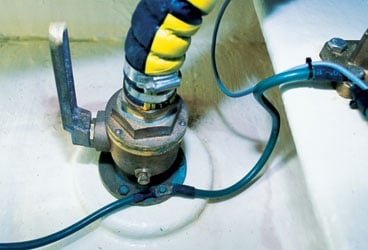
leaky and frozen valves 368
There’s more to a reliable seacock than a through-hull and a valve. Too often, what passes for a seacock is in fact a mismatched collection of plumbing components, the most common of which pairs a through-hull fitting, the mushroom-shaped male threaded component, with an in-line ball valve.
Regardless of the quality of the construction, these components are poorly mated for one exceedingly simple reason: The threads are entirely incompatible. Through-hull fittings use straight, or NPS, threads, while in-line ball valves rely on tapered, or NPT, threads. The two may initially seem to fit; however, it’s difficult to obtain more than two or three threads of engagement. Instead, use purpose-made, flanged, marine sea valves, all of which have the appropriate threads. And never-repeat, never-use a standard gate valve (similar to what’s used with garden hoses) on a boat. If you have one, replace it.
Seacocks are primarily available in two materials: bronze and plastic. There’s much more to the story, though, than simply selecting one material or the other. Bronze is an alloy of copper and tin and sometimes other elements. Bronzes, to distinguish them from brass, an alloy consisting essentially of copper and zinc in variable proportions, are often referred to as “zinc-free copper alloys.” When it comes to seacocks, zinc is the issue: Bronze seacocks must be made of an alloy that contains little or no zinc.
Determining what a valve is made of can be difficult, if not impossible. But if it carries a UL Marine Sea Valve symbol or name plate, you can be certain that it’s made of the proper alloy. Brass valves don’t belong on boats, except for use with the plumbing for liquids other than raw water, such as fuel and potable water. Leaded red brass, used to make many pipe nipples (straight pipe lengths that are threaded on both ends), is suitable for marine use because zinc constitutes no more than 15 percent of its alloy.
Plastic or nonmetallic seacocks and through-hull fittings should be made of glass-reinforced polymers, such as Forespar’s Marelon. Like brass, such plastics as PVC and nylon should never be used in raw-water applications.
Different kinds of seacocks require different kinds of maintenance. For the kind that’s flanged and has a ball valve, little is required in order to keep them operational, although they’re liable to become fouled with growth. Their Teflon seals and chrome-plated balls are self-lubricating; like all seacocks, they benefit from monthly exercise or cycling.
Nonmetallic seacocks benefit from periodic greasing, which requires the removal of the hose to expose the ball. Clean the ball, dry it, and coat it with marine grease. My preference for the lubrication of all seacocks except those that use rubber balls or cones is Lubrimatic’s Marine Trailer Wheel Bearing Grease (www.plews-edelmann.com); this lubricant is water-insoluble, sticky, and, unlike silicone, lithium, and other “light” greases, it resists washing off. Rubber cone valves call for a lubricant, such as silicone, that isn’t petroleum based.
More traditional cone-style bronze seacocks can be disassembled and lubricated for many years of service. Do this annually; certainly do it every three years. Take the seacock apart, clean it with a solvent such as mineral spirits, and sand it with emery cloth to remove any irregularities. Then lap it using valve-grinding compound, apply lubrication, and reassemble.
Some seacocks can be temporarily fit with grease, or zerk, fittings, which can be installed in the drain plugs. With the seacock open, grease is pumped into the cone area. Because most zerk fittings are made of mild steel (or sometimes stainless steel), they shouldn’t be left in place. Make certain that the drain plug isn’t corroded before it’s reinstalled. If a new plug is needed, make sure it’s bronze.
Steve D’Antonio, a regular Cruising World contributor, offers services for vessel owners, boatbuilders, and others in the marine industry through his company, Steve D’Antonio Marine Consulting (www.stevedmarine
consulting.com).








